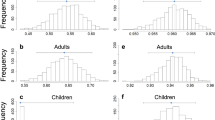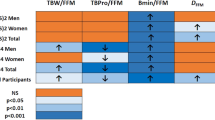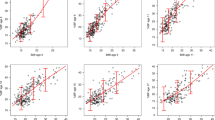Abstract
BACKGROUND: The energy content of weight change is assumed to be sex- and age-neutral at 3500 kcal/pound or 32.2 MJ/kg.
OBJECTIVES: As sexual dimorphism in body composition generally exists in mammals, the primary hypothesis advanced and tested was that the energy content of weight change differs between men and women.
DESIGN: The energy content of 129 adult men and 287 women was measured by neutron activation analysis. Cross-sectional energy content prediction models were developed and then evaluated in two longitudinal samples: one that used the same methods in 26 obese women losing weight; and the other a compilation of 18 previously reported weight change–body composition studies.
RESULTS: Multiple regression modeling identified weight, sex, age and height as total energy content predictor variables with significant sex×weight (P<0.001) and age×weight (P<0.001) interactions; total model r2 and s.e.e. were 0.89 and 107.3 MJ, respectively. The model's predictive value was supported in both longitudinal evaluation samples. Model calculations using characteristics of representative adults gaining or losing weight suggested that the energy content of weight change in women (∼30.1–32.2 MJ/kg) is near to the classical value of 32.2 MJ/kg and that in men the value is substantially lower, ∼21.8–23.8 MJ/kg. The predicted energy content of weight change increases by about 10% in older (age ∼70 y) vs younger (∼35 y) men and women.
CONCLUSIONS: Sexual dimorphism and age-dependency appears to exist in the estimated energy content of weight change and these observations have important clinical and research implications.
This is a preview of subscription content, access via your institution
Access options
Subscribe to this journal
Receive 12 print issues and online access
$259.00 per year
only $21.58 per issue
Buy this article
- Purchase on Springer Link
- Instant access to full article PDF
Prices may be subject to local taxes which are calculated during checkout





Similar content being viewed by others
References
Wishnofsky M . Caloric equivalent of gained or lost weight Metabolism 1952 1: 554–555.
Food and Nutrition Board. In: Thomas PR (ed.) Weighing the options: criteria for evaluating weight-management programs National Academy Press: Washington, DC 1995.
Whitney EN, Rolfes SR . Understanding Nutrition West: St Paul, MN 1993.
Robinson CH, Lawler MR, Chenoweth WL, Garwick AE (eds). Normal and therapeutic nutrition Macmillan: New York 1986.
Zeman FJ (ed.). Clinical nutrition and dietetics Macmillan: New York 1990.
Garrow JS . Energy balance and obesity in man Elsevier Biomedical Press: Oxford 1978.
McArdle WD, Katch FJ, Katch VL (eds). Exercise physiology Williams & Wilkins, Baltimore, MD 1991.
VanItallie TB, Simopoulos AR, Gullo SP, Futterweit W (eds). Obesity: new directions and assessment and management The Charles Press: Philadelphia, PA 1995.
Hunt SM, Groff JL (eds). Advanced nutrition and human metabolism West: St Paul, MN 1990.
Dole VP, Schwartz IL, Thorn NA, Silver L . The caloric value of labile body tissue in obese subjects J Clin Invest 1955 34: 590–594.
Webster JD, Hesp R, Garrow JS . The composition of excess weight in obese women estimated by body density, total body water and total body potassium Hum Nutr Clin Nutr 1984 38: 299–306.
Forbes GB, Brown MR, Welle SL, Lipinski B . Deliberate overfeeding in women and men: energy cost and composition of the weight gain Br J Nutr 1986 56: 1–9.
Passmore R, Strong JA, Ritchie FJ . The chemical composition of the tissue lost by obese patients on a reducing regimen Br J Nutr 1958 12: 113–122.
Boozer CN, Schoenbach G, Atkinson RL . Dietary fat and adiposity: a dose response relationship in adult male rats fed isocalorically Am J Physiol 1995 31: E546–550.
Ballor DL, Poehlman ET . Exercise-training enhances fat-free mass preservation during diet-induced weight loss: a meta-analytical finding Int J Obes Relat Metab Disord 1994 18: 35–40.
Grande F . Nutrition and energy balance in body composition study In: Techniques for measuring body composition Washington, DC. National Academy of Sciences–National Research Council 1961.
Forbes GB . Lean body mass-body fat interrelationships in humans Nutr Rev 1987 45: 225–231.
Forbes GB . Body fat content influences the body composition response to nutrition and exercise Ann NY Acad Sci 2000 904: 359–365 (Special issue Yasumura S, Wang J, Pierson RN Jr (eds). In vivo body composition studies.)
Short RV, Balaban E (eds). The differences between the sexes Cambridge University Press: Cambridge 1994.
Reiss MJ . The allometry of growth and reproduction Cambridge University Press: Cambridge 1989.
Pond CM . The fats of life Cambridge University Press: Cambridge 1998.
Garrow JS (ed.). Energy balance and obesity in man Elsevier Biomedical Press: Oxford 1978.
Forbes GB . Human body composition, growth, aging, nutrition, and activity Springer: New York 1987.
Roberts SB, Fuss P, Heyman MB, Evans WJ, Tsay R, Rasmussen H, Fiatarone M, Cortiella J, Dallal GE, Young VR . Control of food intake in older men JAMA 1994 272: 1601–1606.
Mazariegos M, Kral JG, Wang J, Waki M, Heymsfield SB, Pierson RN Jr, Thornton JC, Yasumura S . Body composition and surgical treatment of obesity: effects of weight loss on fluid distribution Ann Surg 1992 216: 69–73.
Leone P, Galllagher D, Wang J, Heymsfield SB . Relative overhydration of fat-free mass in postobese versus never-obese subjects Ann NY Acad Sci 2000 904: 514–519.
Pierson RN Jr, Wang J, Colt EWD, Neuman P . Body composition measurements in normal man: the potassium, sodium, sulphate and tritium spaces in 58 adults J Chron Dis 1982 35: 419–428.
Pierson RN Jr, Lin DHY, Phillips RA . Total body potassium in health: effects of age, sex, height, and fat Am J Physiol 1974 226: 206–212.
Cohn SH, Vartsky D, Yasumura S, Sawitsky A, Zanzi I, Vaswani A, Ellis KJ . Compartmental body composition based on total-body nitrogen, potassium, and calcium Am J Physiol 1980 39: E524–530.
Dilmanian FA, Weber DA, Yasumura S, Kamen Y, Lidofsky L . Performance of the neutron activation systems at Brookhaven National Laboratory In: Yasumura S, McNeill KG, Woodhead AD, Dilmanian FA (eds) Advances in vivo body composition studies Plenum Press: New York 1990.
Moore FD, Olesen KH, McMurrey JD, Parker HV, Ball MR, Boyden CM (eds). The body cell mass and its supporting environment WB Saunders, Philadelphia, PA 1963.
Schneider G, Kolesnik S, Arbo J, Wang J, Pierson RN Jr . Total body potassium measurement: accuracy, efficiency, and reproducibility FASEB J 1998 12: A868.
Ma K, Kotler D, Wang J, Thornton JC, Ma R, Pierson RN Jr . Reliability of in vivo neutron activation analysis for measuring body composition: comparisons with tracer dilution and dual energy x-ray absorptiometry J Lab Clin Med 1996 127: 420–427.
Merrill AL, Watt BK . Energy value of foods USDA Handbook 74. US Government Printing Office: Washington, DC 1955.
Shutz Y . Glossary of energy terms and factors used for calculations of energy metabolism in human studies In: Van Es AJH (ed.) Human energy metabolism: physical activity and energy expenditure measurements in epidemiological research based upon direct and indirect calorimetry Euro Nut Report 5. Euro Nut: Wageningen 1984 pp 169–181.
Snyder WS, Cook MJ, Nasset ES, Karhausen LR, Howells GP, Tipton IH . Report of the task group on Reference Man Pergamon Press: Oxford 1975.
Wang ZM, Deurenberg P, Guo SS, Pietrobelli A, Wang J, Pierson RN Jr, Heymsfield SB . Six-compartment body composition model: inter-method comparisons of total body fat measurement Int J Obes Relat Metab Disord 1998 22: 329–337.
Heymsfield SB, McManus C III, Seitz S, Nixon D, Smith J . Anthropometric assessment of adult protein-energy malnutrition In: Wright RA, Heymsfield SB (eds) Nutritional assessment of the hospitalized patient Blackwell Scientific: Boston, MA 1984 pp 27–82.
Neter J, Wasserman W, Kutner MH . Applied linear regression models Irwin: Boston, MA 1998.
Bland JM, Altman DG . Statistical methods for assessing agreement between two methods of clinical measurement Lancet 1986 1: 307–310.
Raben NJ, Mygind E, Astrup A . Lower activity of oxidative key enzymes and smaller fiber areas in skeletal muscle of postobese women Am J Physiol 1998 275: E487–494.
Toubro SP, Western J, Bulow I, Macdonald A, Raben NJ, Christenesen J, Madsen J, Astrup A . Insulin sensitivity in post-obese women Clin Sci 1994 87: 407–413.
Leibel RL, Rosenbaum M, Hirsh J . Changes in energy expenditure resulting from altered body weight New Engl J Med 1995 332: 621–628.
Weinsier RL, Nelson KM, Hensrud DD, Darnell BE, Hunter GR, Schutz Y . Metabolic predictors of obesity J Clin Invest 1995 95: 980–985.
Eckel RH, Yost TJ, Jensen DR . Sustained weight reduction in moderately obese women results in decreased activity of skeletal muscle lipoprotein lipase Eur J Clin Invest 1995 25: 396–402.
Van der Kooy K, Leenen R, Deurenberg P, Seidell JC, Westerterp KR, Hautvast JGAJ . Changes in fat-free mass in obese subjects after weight loss: a comparison of body composition measures Int J Obes Relat Metab Disord 1992 16: 675–683.
Marks BL, Ward A, Morris DH, Castellani J, Rippe JM . Fat-free mass is maintained in women following a moderate diet and exercise program Med Sci Sports Exercise 1995 27: 1243–1251.
Ballor DL, Poehlman ET . Exercise-training enhances fat-free mass preservation during diet-induced weight loss: a meta-analytical finding Int J Obes Relat Metab Disord 1994 18: 35–40.
Nicklas BJ, Rogus ME, Goldberg AP . Exercise blunts declines in lipolysis and fat oxidation after dietary-induced weight loss in obese older women Am J Physiol 1997 273: 149–155.
Dengel DR, Pratley RE, Hagberg JM, Rogus EM, Goldberg AP . Distinct effects of aerobic exercise training and weight loss on glucose homeostasis in obese sedentary men Am J Physiol 1996 81: 318–325.
Dengel DR, Hagberg JM, Coon PJ, Drinkwater DT, Goldberg AP . Effects of weight loss by diet alone or combined with aerobic exercise on body composition in older obese men Metabolism 1994 43: 867–871.
Wadden TA, Foster GD, Stunkard AJ, Conill AM . Effects of weight cycling on the resting energy expenditure and body composition of obese women Int J Eat Disord 1996 19: 5–12.
Pasman WJ, Westerterp-Plantenga MS, Saris WHM . The effect of body weight changes and endurance training on 24h substrate oxidation Int J Obes Relat Metab Disord 1999 6: 1223–1232.
Keys A, Brozek J, Henschel A, Mickelsen O, Taylor HS . The biology of human starvation University of Minnesota Press: Minneapolis, MN 1950.
Wang ZM, Heshka S, Pierson RN Jr, Heymsfield SB . Systematic organization of body-composition methodology: an overview with emphasis on component-based methods Am J Clin Nutr 1995 61: 457–465.
Visser M, Gallagher D, Deurenberg P, Wang J, Pierson RN Jr, Heymsfield SB . Density of fat-free body mass: relationship with race, age, and level of body fatness Am J Physiol 1997 272: 781–787.
Durrant ML, Garrow JS, Royston P, Stalley SF, Sunkin S, Warwick PM . Factors influencing the composition of the weight lost by obese patients on a reducing diet Br J Nutr 1980 44: 275–285.
Elia M, Stubbs RJ, Henry CJK . Differences in fat, carbohydrate, and protein metabolism between lean and obese subjects undergoing total starvation Obes Res 1999 7: 597–604.
Alpert S . The energy density of weight loss in semistarvation Int J Obes 1988 12: 533–542.
Garrow JS, Summerbell CD . Meta-analysis: effect of exercise, with or without dieting, on the body composition of overweight adults Eur J Clin Nutr 1995 49: 1–10.
Acknowledgements
Supported by National Institutes of Health Grants RR00645 and NIDDK 42618, 51716, 26687.
Author information
Authors and Affiliations
Corresponding author
Rights and permissions
About this article
Cite this article
Pietrobelli, A., Allison, D., Heshka, S. et al. Sexual dimorphism in the energy content of weight change. Int J Obes 26, 1339–1348 (2002). https://doi.org/10.1038/sj.ijo.0802065
Received:
Revised:
Accepted:
Published:
Issue Date:
DOI: https://doi.org/10.1038/sj.ijo.0802065
Keywords
This article is cited by
-
Sex differences in energy metabolism: natural selection, mechanisms and consequences
Nature Reviews Nephrology (2024)
-
Sex-specific genetic architecture of human fatness in Chinese: the SAPPHIRe Study
Human Genetics (2010)
-
Counting calories: not so easy
Nature (2008)
-
What is the required energy deficit per unit weight loss?
International Journal of Obesity (2008)
-
Bioelectrical Impedance vs. Four‐compartment Model to Assess Body Fat Change in Overweight Adults
Obesity (2007)



